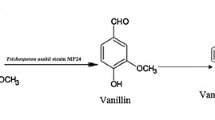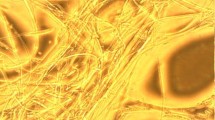Abstract
An extractive biocatalytic method of aqueous two-phase system was employed for stereoinversing (R)-1-phenyl-1,2-ethanediol into (S)-1-phenyl-1,2-ethanediol by Candida parapsilosis CCTCC M203011. It was observed that substrate and product inhibitions in microbial stereoinversion through one-pot oxidation and reduction were removed efficiently by extractive biocatalysis in aqueous two-phase system with PEG 4000/phosphate potassium system, and that the substrate concentration was enhanced from 15 to 30 g/L with product optical purity of 99.02% e.e. and yield of 90% after 60 h. Simultaneously, it was observed that change in cell morphology impedes the further enhancement of substrate concentration in this system but can be reversibly changed after stereoinversion or cultivation in systems without PEG.









Similar content being viewed by others
References
Itoh N, Matsuda M, Mabuchi M, Dairi T, Wang J (2002) Chiral alcohol production by NADH-dependent phenylacetaldehyde reductase coupled with in situ regeneration of NADH. Eur J Biochem 269:2394–2402
Katz M, Frejd T, Hahn HB, Gorwa-Grausland MF (2003) Efficient anaerobic whole cell stereoselective bioreduction with recombinant Saccharomyces cerevisiae. Biotechnol Bioeng 84:573–582
Gruber CC, Lavandera I, Faber K, Kroutil W (2006) From a racemate to a single enantiomer: deracemization by stereoinversion. Adv Synth Catal 348:1789–1805
Nie Y, Xu Y, Yang M, Mu XQ (2007) A novel NADH-dependent carbonyl reductase with unusual stereoselectivity for (R)-specific reduction from an (S)-1-phenyl-1,2-ethanediol-producing micro-organism: purification and characterization. Lett Appl Microbiol 44:555–562
Jaeger KE, Eggert T (2004) Enantioselective biocatalysis optimized by directed evolution. Curr Opin Biotechnol 15:305–313
Hasegawa J, Ogura M, Tsuda S, Maemoto S, Kutsuki H, Ohashi T (1990) High-yield production of optically-active 1,2-diols from the corresponding racemates by microbial stereoinversion. Agric Biological Chem 54:1819–1827
Nie Y, Xu Y, Mu XQ (2004) Highly enantioselective conversion of racemic 1-phenyl-1,2-ethanediol by stereoinversion: involving a novel cofactor-dependent oxidoreduction system of Candida parapsilosis CCTCC M203011. Org Process Res Dev 2:246–251
Ren YQ, Xu Y, Mu XQ, Nie Y (2005) Improving enantioselectivity of Candida parapsilosis for deracemization of (R,S)-1-phenyl-1,2-ethanediol by addition of alcohols during cell cultivation. China J Process Eng 5:554–557
Fujiwara S, Yamanaka A, Yamada Y, Hirooka K, Higashibata H, Fukuda W, Nakayama JI, Imanaka T, Fukusaki EI (2008) Efficient synthesis of trans-polyisoprene compounds using two thermostable enzymes in an organic-aqueous dual-liquid phase system. Biochem Biophys Res Commun 365:118–123
Zhang WG, Wei DZ, Yang XP, Song QX (2006) Penicillin acylase catalysis in the presence of ionic liquids. Bioprocess Biosyst Eng 29:379–383
Grivel F, Larroche C (2001) Phase transfer and biocatalyst behaviour during biotransformation of [beta]-ionone in a two-phase liquid system by immobilised Aspergillus niger. Biochem Eng J 7:27–34
de Carvalho C, da Fonseca MMR (2004) Solvent toxicity in organic-aqueous systems analysed by multivariate analysis. Bioprocess Biosyst Eng 26:361–375
Wang L, Wang ZL, Xu JH, Bao D, Qi HS (2006) An eco-friendly and sustainable process for enzymatic hydrolysis of penicillin G in cloud point system. Bioprocess Biosyst Eng 29:157–162
Wang Z, Zhao F, Hao X, Chen D, Li D (2004) Microbial transformation of hydrophobic compound in cloud point system. J Mol Catal B 27:147–153
Igarashi L, Kieckbusch TG, Franco TT (2004) Xylanase mass transfer studies in aqueous two-phase systems using spray and sieve plate columns. Bioprocess Biosyst Eng 26:151–157
Antov M, Omorjan R (2009) Pectinase partitioning in polyethylene glycol 1000/Na2SO4 aqueous two-phase system: statistical modeling of the experimental results. Bioprocess Biosyst Eng 32:235–240
Schindler J, Nothwang HG (2006) Aqueous polymer two-phase systems: effective tools for plasma membrane proteomics. Proteomics 6:5409–5417
Andersson E, Hahn HB (1990) Bioconversions in aqueous two-phase systems. Enzym Microb Technol 12:242–254
Terreni M, Ubiali D, Pagani G, Hernandez JO, Fernandez LR, Guisan JM (2005) Penicillin G acylase catalyzed acylation of 7-ACA in aqueous two-phase systems using kinetically and thermodynamically controlled strategies: improved enzymatic synthesis of 7-[(1-hydroxy-1-phenyl)-acetamido]-3-acetoxymethyl-Delta(3)-cephem-4-carboxylic acid. Enzym Microb Technol 36:672–679
Banik RM, Santhiagu A, Kanari B, Sabarinath C, Upadhyay SN (2003) Technological aspects of extractive fermentation using aqueous two-phase systems. World J Microbiol Biotechnol 19:337–348
Chen JP, Lee MS (1995) Enhanced production of Serratia marcescens chitinase in PEG/dextran aqueous two-phase systems. Enzym Microb Technol 17:1021–1027
Planas J, Lefebvre D, Tjerneld F, Hahn HB (1997) Analysis of phase composition in aqueous two-phase systems using a two-column chromatographic method: application to lactic acid production by extractive fermentation. Biotechnol Bioeng 54:303–311
Bassani G, Farruggia B, Nerli B, Romanini D, Pico G (2007) Porcine pancreatic lipase partition in potassium phosphate-polyethylene glycol aqueous two-phase systems. J Chromatogr B 859:222–228
Albertsson PA (1986) Partition of cell particles and macromolecules. Wiley, New York
Mu XQ, Xu Y, Nie Y, Ouyang J, Sun ZH (2005) Candida parapsilosis CCTCC M203011 and the optimization of fermentation medium for stereoinversion of (S)-1-phenyl-1,2-ethanediol. Process Biochem 7:2345–2350
Wang ZH, Ma HM, Ma QL, Su MH, Liang SQ (2001) Study on two-phase aqueous extraction system. China J Appl Chem 18:173–175
Jozala AF, Lopes AM, Mazzola PG, Magalhaes PO, Vessoni Penna TC, Pessoa A Jr (2008) Liquid–liquid extraction of commercial and biosynthesized nisin by aqueous two-phase micellar systems. Enzym Microb Technol 42:107–112
Babu BR, Rastogi NK, Raghavarao KSMS (2008) Liquid–liquid extraction of bromelain and polyphenol oxidase using aqueous two-phase system. Chem Eng Process 47:83–89
Bertoluzzo MG, Rigatuso R, Farruggia B, Nerli B, Pico G (2007) Cosolutes effects on aqueous two-phase systems equilibrium formation studied by physical approaches. Colloids Surf B 59:134–140
Lu TF, Xu Y, Mu XQ, Nie Y (2007) Promotion effect of xylose co-substrate on stability of catalytic system for asymmetric redox of (R,S)-1-phenyl-1,2-ethanediol to its (S)-enantiomer by Candida parapsilosis. China J Catal 28:446–450
Acknowledgments
We would like to thank the National Science Foundation of China (NSFC) (No. 20376031, 20776060 and 30800017) and the National Key Basic Research and Development Program of China (973 program) (2009CB724706), the Ministry of Education, the Hi-Tech Research and Development Program of China (2007AA02Z226), the Program for Changjiang Scholars and Innovative Research Team in University IRT0532 and Jiangsu Development Strategies of Science and Technology (BG2007008), for their financial support.
Author information
Authors and Affiliations
Corresponding author
Rights and permissions
About this article
Cite this article
Xu, Mw., Mu, Xq. & Xu, Y. Enhancement of substrate concentration in microbial stereoinversion through one-pot oxidation and reduction by aqueous two-phase system. Bioprocess Biosyst Eng 33, 367–373 (2010). https://doi.org/10.1007/s00449-009-0334-9
Received:
Revised:
Accepted:
Published:
Issue Date:
DOI: https://doi.org/10.1007/s00449-009-0334-9




